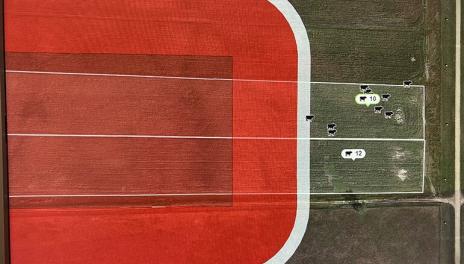NDSU Extension, Central Grasslands REC Explore High-Tech Cattle Grazing Management
Imagine it is 8 p.m. and you just sat down in your recliner after a long day of ranch work. Your mind goes over the things you need to get done tomorrow, but one of those things can be done tonight with the click of your laptop mouse. In just a few seconds, you’ve opened up a new section of pasture for your cattle to graze. No moving fences, no time spent outside in the cold. Sounds high-tech, right?
From June to November of this year, NDSU Extension specialists and researchers at the Central Grasslands Research Extension Center (CGREC), near Streeter, North Dakota, have been piloting the use of virtual fencing to explore precision grazing management strategies.
Virtual fencing, a relatively new technology, allows ranchers to control livestock distribution in a pasture without physical fences. Livestock wear collars that communicate with GPS and reception towers to form a virtual fence set by the rancher. This technology allows ranchers to track their animals in real time and move them to specified areas within a pasture using computer software.
When an animal wearing a virtual fence collar gets too close to a virtual fence boundary, a series of beeps alert the animal to move away from the fence.
“Virtual fencing as a tool to implement rotational grazing could have many potential benefits, with the largest benefits being time and labor savings,” says Zac Carlson, NDSU Extension beef cattle specialist. “Other benefits may include better pasture management, and therefore increased animal performance and efficiency.”
In addition to more traditional grazing systems, they are testing the use of virtual fence to graze cropland. “The focus of this research is to evaluate strip grazing and grazing technologies on soil health, animal performance and behavior, and economic viability for cattle producers,” says Miranda Meehan, NDSU Extension livestock environmental stewardship specialist.
“This past fall we tested three different techniques of strip-grazing a cover crop, including manual fence movement, automated fence movement and virtual fence at the CGREC,” says Kevin Sedivec, CGREC director and NDSU Extension rangeland management specialist. “We also tested the use of virtual fencing for rotational graze of cow/calf pairs on summer pasture to assess livestock performance and degree of use patterns.”
While the benefits of virtual fencing seem exciting, the researchers are also exploring whether the cost of the technology and initial labor of set-up may prohibit its use for most ranchers.
Meehan, Carlson and Sedivec will be sharing the initial findings of their research in the spring of 2024 through NDSU Extension Café Talks, social media and other outreach efforts.
This research was funded through a U.S. Department of Agriculture cooperative agreement on precision agriculture, and grants from the State Board of Agriculture Research and Extension and North Central Sustainable Agriculture Research and Education program.
Through collaborations with the North Dakota Agricultural Experiment Station and with colleagues at the University of Nebraska – Lincoln, the research will continue through 2026.
FOR MORE INFORMATION:
Miranda Meehan, 701-231-7683, miranda.meehan@ndsu.edu
Kevin Sedivec, 701-424-3606, kevin.sedivec@ndsu.edu
Zac Carlson, 701-231-1884, zachary.e.carlson@ndsu.edu
